 Question 1: In the adjoining figure,
Question 1: In the adjoining figure, and
are two points on equal sides
and
of
such that
. Prove that
.
Answer:
Consider and
(given)
is common
(given)
Therefore (by S.A.S theorem)
Hence
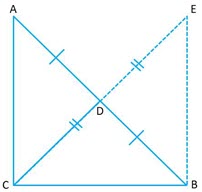 Question 2: If
Question 2: If is the mid point of the hypotenuse
of a right triangle
, prove that
.
Answer:
Construct ABD such that ABD = DE
Consider and
(given)
(vertically opposite angles)
(constructed)
Therefore (by S.A.S theorem)
and
(interior angles on the same side of the transversal are supplementary)
Therefore and
are right angle triangles.
Therefore
is common
Therefore
. Hence proved.
 Question 3: In a quadrilateral
Question 3: In a quadrilateral and
bisects
. Show that
. What can you say about
and
.
Answer:
Consider and
(given)
(given)
is common
Therefore (by S.A.S theorem)
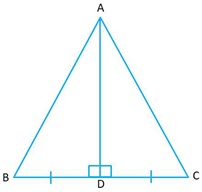 Question 4: Prove that
Question 4: Prove that is isosceles if any of the following holds: (i) Altitude
bisects
(ii) Median
is perpendicular to the base
.
Answer:
(i) If
Consider and
is common
(altitude is perpendicular to the base)
(given)
Therefore
Therefore is isosceles triangle.
(ii) If Median is perpendicular to the base
is common
(since
is the median,
is the midpoint of
)
Therefore
Therefore is isosceles triangle.
 Question 5: In the adjoining figure
Question 5: In the adjoining figure and
. Prove that
,
and
.
Answer:
Consider and
is given
given
(is common)
Therefore
Therefore and
 Question 6: In the adjoining figure,
Question 6: In the adjoining figure, ,
and
. Prove that
Answer:
Given ,
and
Therefore (by S.A.S theorem)
 Question 7: In a
Question 7: In a , and
and
are midpoints of the sides
and
respectively. Prove that
.
Answer:
Given
Consider and
Therefore
 Question 8: In the adjoining figure,
Question 8: In the adjoining figure, is a square and
is an equilateral triangle. Prove that (i)
(ii)
Answer:
Consider and
(equilateral triangle)
(sides of a square)
Since and
Therefore
In
Therefore
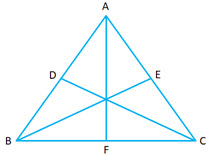 Question 9: Prove that the median of an equilateral triangle are equal.
Question 9: Prove that the median of an equilateral triangle are equal.
Answer:
Given:
is equilateral
Therefore
To prove:
Consider and
is an equilateral triangle)
is an equilateral triangle)
(medians bisect the opposite side. Since
is an equilateral triangle the sides are equal)
Therefore
Now consider and
is an equilateral triangle)
is an equilateral triangle)
Therefore
Hence
Hence we can say that
 Question 10:
Question 10: is a line segment.
and
are points on opposite sides of
such that each of them is equidistant from the points
and
. Show that the line
is perpendicular bisector of
.
Answer:
Consider and
(given)
(bisector)
is common
Therefore
Therefore
Similarly in and
is common
Therefore
Therefore is a perpendicular bisector of
 Question 11: In the adjoining figure,
Question 11: In the adjoining figure, and
, find the ratio
Answer:
Since
Also since
Now
 Question 12: In the adjoining figure,
Question 12: In the adjoining figure, and
. Prove that
and
.
Answer:
Given:
Since
Therefore
Therefore in and
, we have
is common
Therefore (A.S.A. theorem)
Hence and
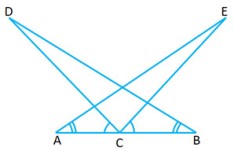 Question 13: In the adjoining figure,
Question 13: In the adjoining figure, and
. Prove that
and hence
and $latex $latex
.
Answer:
Given:
Consider and
(Proved above)
(given)
(given)
Therefore (A.S.A theorem)
Therefore and
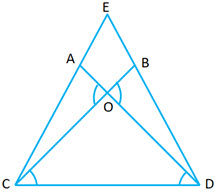 Question 14: In the adjoining figure, it is given that
Question 14: In the adjoining figure, it is given that and
. Prove that
.
Answer:
Consider , we have
… … … … … (i)
We have (vertically opposite angles)
… … … … … (ii)
Subtracting (ii) from (i) we get
Therefore in and
, we have
(common angle)
(given) and
Therefore (A.S.A. theorem)
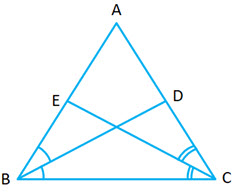 Question 15:
Question 15: and
are bisectors of
and
of an isosceles
with
. Prove that
.
Answer:
Given: bisects the
Similarly, bisects the
Since is an isosceles triangle,
Consider and
is common
Since
Hence (A.S.A theorem)
